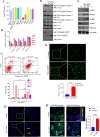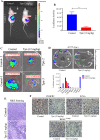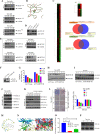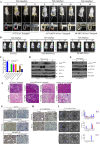Pharmacological attenuation of melanoma by tryptanthrin pertains to the suppression of MITF-M through MEK/ERK signaling axis
- PMID: 35948813
- PMCID: PMC11072980
- DOI: 10.1007/s00018-022-04476-y
Pharmacological attenuation of melanoma by tryptanthrin pertains to the suppression of MITF-M through MEK/ERK signaling axis
Abstract
Melanoma is the most aggressive among all types of skin cancers. The current strategies against melanoma utilize BRAFV600E, as a focal point for targeted therapy. However, therapy resistance developed in melanoma patients against the conventional anti-melanoma drugs hinders the ultimate benefits of targeted therapies. A major mechanism by which melanoma cells attain therapy resistance is via the activation of microphthalmia-associated transcription factor-M (MITF-M), the key transcription factor and oncogene aiding the survival of melanoma cells. We demonstrate that tryptanthrin (Tpn), an indole quinazoline alkaloid, which we isolated and characterized from Wrightia tinctoria, exhibits remarkable anti-tumor activity towards human melanoma through the down-regulation of MITF-M. Microarray analysis of Tpn-treated melanoma cells followed by a STRING protein association network analysis revealed that differential expression of genes in melanoma converges at MITF-M. Furthermore, in vitro and in vivo studies conducted using melanoma cells with differential MITF-M expression status, endogenously or ectopically, demonstrated that the anti-melanoma activity of Tpn is decisively contingent on its efficacy in down-regulating MITF-M expression. Tpn potentiates the degradation of MITF-M via the modulation of MEK1/2-ERK1/2-MITF-M signaling cascades. Murine models demonstrate the efficacy of Tpn in attenuating the migration and metastasis of melanoma cells, while remaining pharmacologically safe. In addition, Tpn suppresses the expression of mutated BRAFV600E and inhibits Casein Kinase 2α, a pro-survival enzyme that regulates ERK1/2 homeostasis in many tumor types, including melanoma. Together, we point to a promising anti-melanoma drug in Tpn, by virtue of its attributes to impede melanoma invasion and metastasis by attenuating MITF-M.
Keywords: BRAFV600E; CK2α; MITF-M; Melanoma metastasis; Tryptanthrin; VEGFR2; β-catenin.
© 2022. The Author(s), under exclusive licence to Springer Nature Switzerland AG.
Conflict of interest statement
The authors have no relevant financial or non-financial interests to disclose.
Figures






Similar articles
-
Inhibition of oncogenic BRAF activity by indole-3-carbinol disrupts microphthalmia-associated transcription factor expression and arrests melanoma cell proliferation.Mol Carcinog. 2017 Jan;56(1):49-61. doi: 10.1002/mc.22472. Epub 2016 Feb 15. Mol Carcinog. 2017. PMID: 26878440 Free PMC article.
-
Overcoming MITF-conferred drug resistance through dual AURKA/MAPK targeting in human melanoma cells.Cell Death Dis. 2016 Mar 10;7(3):e2135. doi: 10.1038/cddis.2015.369. Cell Death Dis. 2016. PMID: 26962685 Free PMC article.
-
Simultaneous suppression of MITF and BRAF V600E enhanced inhibition of melanoma cell proliferation.Cancer Sci. 2009 Oct;100(10):1863-9. doi: 10.1111/j.1349-7006.2009.01266.x. Epub 2009 Jun 29. Cancer Sci. 2009. PMID: 19659611 Free PMC article.
-
Microphthalmia-associated transcription factor in melanoma development and MAP-kinase pathway targeted therapy.Pigment Cell Melanoma Res. 2015 Jul;28(4):390-406. doi: 10.1111/pcmr.12370. Epub 2015 Apr 17. Pigment Cell Melanoma Res. 2015. PMID: 25818589 Free PMC article. Review.
-
MITF in melanoma: mechanisms behind its expression and activity.Cell Mol Life Sci. 2015 Apr;72(7):1249-60. doi: 10.1007/s00018-014-1791-0. Epub 2014 Nov 30. Cell Mol Life Sci. 2015. PMID: 25433395 Free PMC article. Review.
Cited by
-
Recent advances of tryptanthrin and its derivatives as potential anticancer agents.RSC Med Chem. 2024 Jan 4;15(4):1127-1147. doi: 10.1039/d3md00698k. eCollection 2024 Apr 24. RSC Med Chem. 2024. PMID: 38665827 Free PMC article. Review.
-
Evaluation of In Vitro Anticancer Activity and Apoptotic Potential of Wrightia Tinctoria Bark Extracts on Oral Cancer Cell Lines.Asian Pac J Cancer Prev. 2025 May 1;26(5):1753-1759. doi: 10.31557/APJCP.2025.26.5.1753. Asian Pac J Cancer Prev. 2025. PMID: 40439388 Free PMC article.
-
Tryptanthrin inhibits tumor angiogenesis via Notch/Dll4 signaling pathway in zebrafish.Transl Cancer Res. 2023 Oct 31;12(10):2660-2672. doi: 10.21037/tcr-23-925. Epub 2023 Oct 16. Transl Cancer Res. 2023. PMID: 37969390 Free PMC article.
-
A Novel Tryptanthrin Derivative D6 Induces Apoptosis and DNA Damage in Non-small-cell Lung Cancer Cells Through Regulating the EGFR Pathway.Anticancer Agents Med Chem. 2024;24(17):1275-1287. doi: 10.2174/0118715206303721240715042526. Anticancer Agents Med Chem. 2024. PMID: 39034729
-
Exploring the Anti-Inflammatory Effect of Tryptanthrin by Regulating TLR4/MyD88/ROS/NF-κB, JAK/STAT3, and Keap1/Nrf2 Signaling Pathways.ACS Omega. 2024 Jul 3;9(28):30904-30918. doi: 10.1021/acsomega.4c03795. eCollection 2024 Jul 16. ACS Omega. 2024. PMID: 39035974 Free PMC article.
References
MeSH terms
Substances
LinkOut - more resources
Full Text Sources
Medical
Research Materials
Miscellaneous

